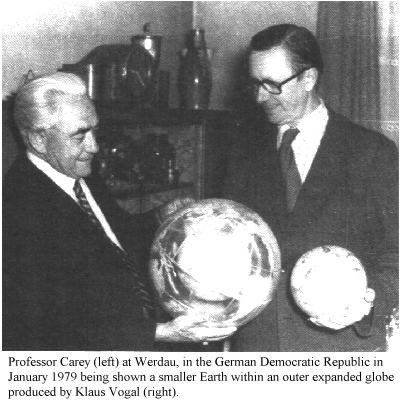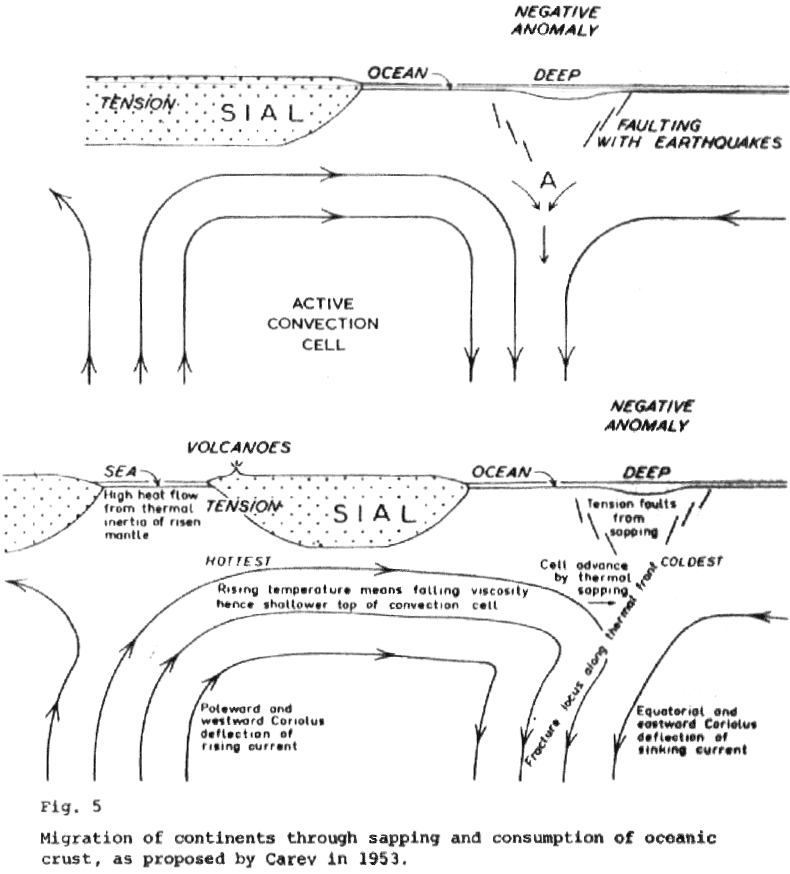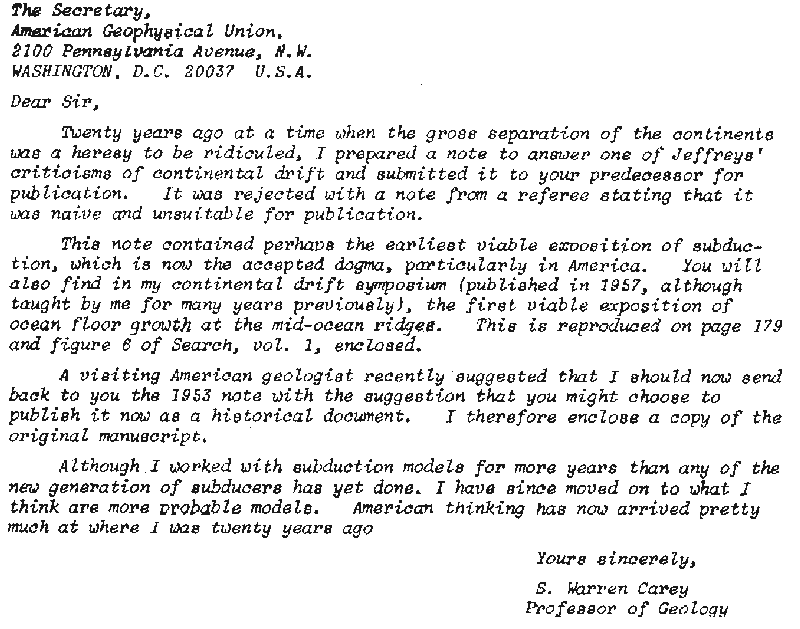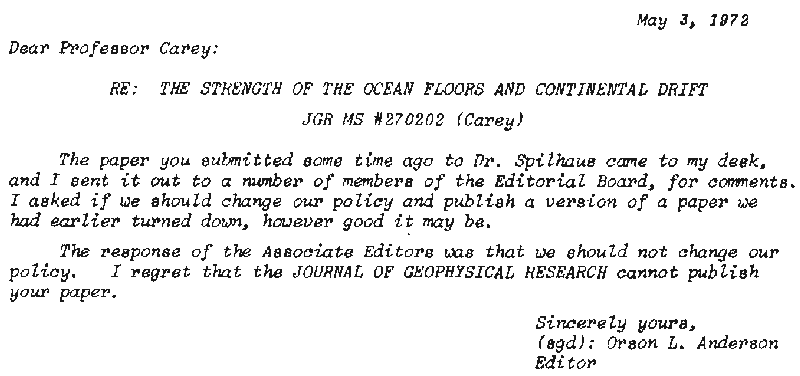 |
| Home |Introduction | Books & Papers | Animations | Expansion Sites | Science Links | Download |
Professor Carey
graduated Doctor of Science from the University of Sydney, and has received
Honorary Doctorates from the Universities of Papua-New Guinea, and of Urbino
(Italy).
 |
Professor S. Warren Carey founded the Geology Department at the University of Tasmania in Hobart, Australia in September 1946.
He served as
He is an Officer of the Order of Australia
Carey's Expanding Earth Model
 Professor
S. Warren Carey founded the Geology Department at the University of Tasmania
in Hobart, Australia in 1946.
Professor
S. Warren Carey founded the Geology Department at the University of Tasmania
in Hobart, Australia in 1946.
Ironically, Carey began his career with a determination to establish the validity of the continental-drift/subduction model. The similarity between what is now referred to as "Plate Tectonics" and what Carey had been teaching in the late 1940's and 1950's is remarkable. Carey has never received recognition for his earlier development of the now accepted subduction model. (See - Carey, S.W., 1958: The tectonic approach to continental drift. Synp. Continental Drift. 1956 Hobart. 177-355)
During the 1940's and into the 1950's Professor Carey taught his students the theory of continental drift with formation of oceanic crust at mid ocean ridges and subsequent subduction of old oceanic crust at deep ocean trench zones to the incredulity of many of his peers. Twenty five years after Carey developed the subduction model, his once dismissive peers flocked en-masse to the effectively identical Plate Tectonic model.
Below is a
letter excerpted from Carey's 1976 book, "The Expanding Earth".
 |
This reply was received six months later:
 |
The subduction model submitted by Carey for publication in 1953 was initially labelled "naive and unsuitable for publication" by the Journal of Geophysical Research, but a decade and a half after this rejection, this subduction model initiated a momentous and far-reaching scientific revolution and is now the unifying basis of all accepted tectonic interpretations. All of today's popularly accepted global tectonic interpretations and derived geological histories hinge on the validity of this subduction model.
 During
1956 Professor Carey convened an International Symposium on the question
of "Continental Drift". At this time Carey realized that subduction
of oceanic crust could not conform to the empirical geological evidence
and unfortunately, mechanically and geometrically it did not work when
applied to the tectonics of the whole globe, nor could any permutation
of subduction. Carey realized he would have to abandon the subduction
model. Rejection of subduction had the effect of disallowing a continental-drift
explanation of the Earth's lithosphere. (See: The Expanding Earth -
Carey, 1976)
During
1956 Professor Carey convened an International Symposium on the question
of "Continental Drift". At this time Carey realized that subduction
of oceanic crust could not conform to the empirical geological evidence
and unfortunately, mechanically and geometrically it did not work when
applied to the tectonics of the whole globe, nor could any permutation
of subduction. Carey realized he would have to abandon the subduction
model. Rejection of subduction had the effect of disallowing a continental-drift
explanation of the Earth's lithosphere. (See: The Expanding Earth -
Carey, 1976)
In years previous to 1956, Carey had made numerous detailed attempts to accurately geometrically reconstruct supercontinent precursors of today's continents. After years of tedious and frustrating detailed attempts, he realized that a reconstruction was geometrically impossible unless the Earth's radius was once much less than today. The only way to accurately cartographically re-assemble a precursor super-continent was to do it on a smaller globe! His smaller-radius-globe super-continent reconstruction went together without the geometric lithospheric anomalies that plagued all earlier attempts.
Carey knew his reconstruction meant that the Earth had been expanding throughout geological time and not just expanding, but expanding at an exponential rate. Since this time Carey has identified many lines of empirical evidence that show that subduction can not be occurring and does not exist. Radiometric dating of the oldest rocks found on continental crust shows that they are a little under 4 billion years old but the oldest oceanic crust is less than 200 million years old!
Put another way:
This process lead to the publication of his first Book "The Expanding Earth" in 1976. This book represented the most unified theory of Earth science published at that time.
Since this first book Carey has continued to develop, refine and advance the Earth expansion model. He has successfully defended the model against all attempts to invalidate it. Carey's later books and papers have shown in lucid detail, that each and every attempt at scientific refutation has failed.
The Earth expansion model is scientifically valid.
ANZAAS NEWS (December 1998)'DRIFT THEORY' ADVOCATE AWARDED ANZAAS MEDAL
An Australian geologist who's theories in the 1950's on Continental Drift had a major global impact on geological thinking has won one of Australia's top scientific medals, the 1998 ANZAAS Medal. The Award to Prof Carey was made at 29th of October in Hobart by, the Chairman of ANZAAS, Prof Paul Adam, during the opening session of the ANZAAS Conference, Year of The Ocean.
Prof Sam Carey, foundation Professor of Geology at the University of Tasmania, sparked a new level of debate about the Gondwanaland theories in 1954 during a symposium held in Hobart. Prof Adam said that during a distinguished professional career Prof Carey had made many outstanding scientific achievements in research and education.
"Your many contributions towards our understanding of the earth and its structure make you a scientist of international significance and an outstanding contributor to the Development of Australian science. As the foundation Professor of Geology at the University of Tasmania, you taught generations of students, many of whom are now eminent geologists and this medal is a mark of the high esteem with which you are held in the Australian scientific community and in recognition of your lifetime of achievements in geology."Born in Campbelltown, NSW, in 1911 Prof Carey was educated at Canterbury Boys High School and University of Sydney, gaining his Doctor of Science in 1939, for work on the, tectonic evolution of New Guinea and Melanesia. He worked in the petroleum industry leading up to and during the war, served with the Australian Infantry Forces (Z Special Force) from 1942~44, after which he began a two-year appointment as Chief Government Geologist in Tasmania. Prof Carey's research on geological structure in Tasmania provided the framework and inspiration for more than a quarter of a century of science. His research also included glacial marine segments, a lightly-researched field of study, and subsequent publications were a stimulus for future work by sedimentologist.Prof Carey was appointed foundation Professor of Geology at the University of Tasmania in 1946, retiring in 1976. He was made an Officer of the Order of Australia in 1977. He was Convenor and Editor of Tasmanian International Symposia on subjects from glacial sedimentation and continental drift to expanding Earth, and has produced more than 60 scientific publications and several books. It was from one of these symposia, that Prof Carey produced his first major publication "The Tectonic Approach to Continental Drift".
Prof Adam said that when the idea of continental movement gained orthodoxy with the acceptance of the plate tectonic theory in the 1970s, he moved to a new field of study centred on expansion of the Earth, and his views culminated in the book "The Expanding Earth" in 1976. Prof Carey is currently writing his fourth book.
EARTH
UNIVERSE COSMOS 1996
(Pre-print
draft)